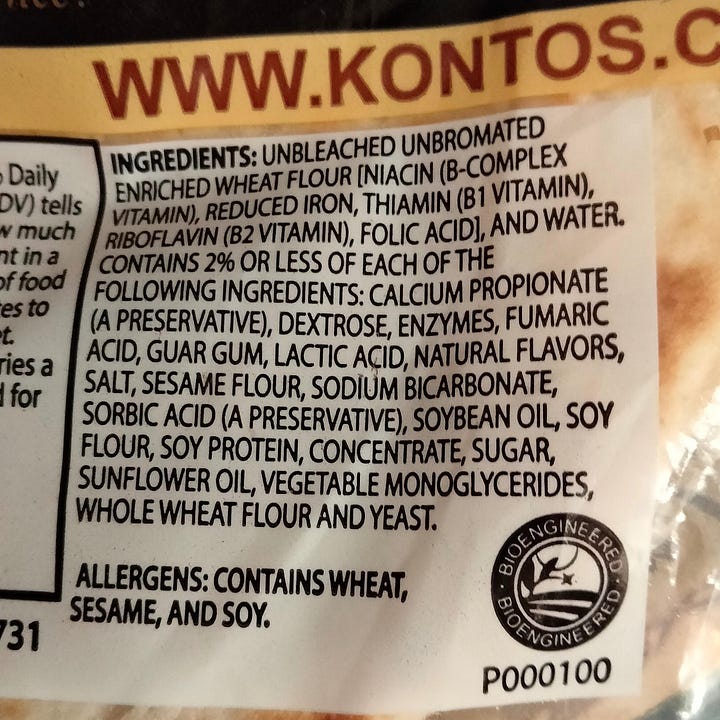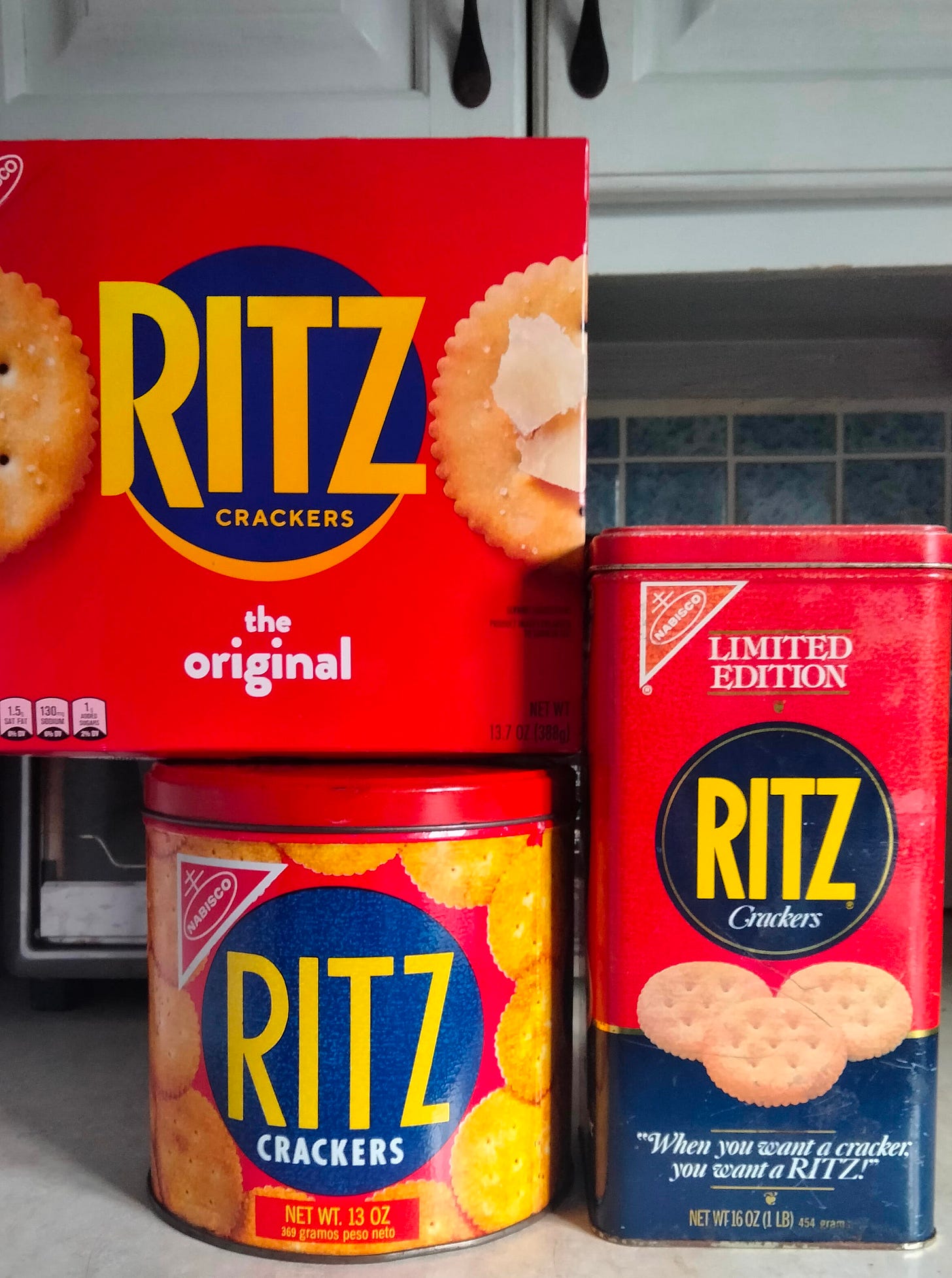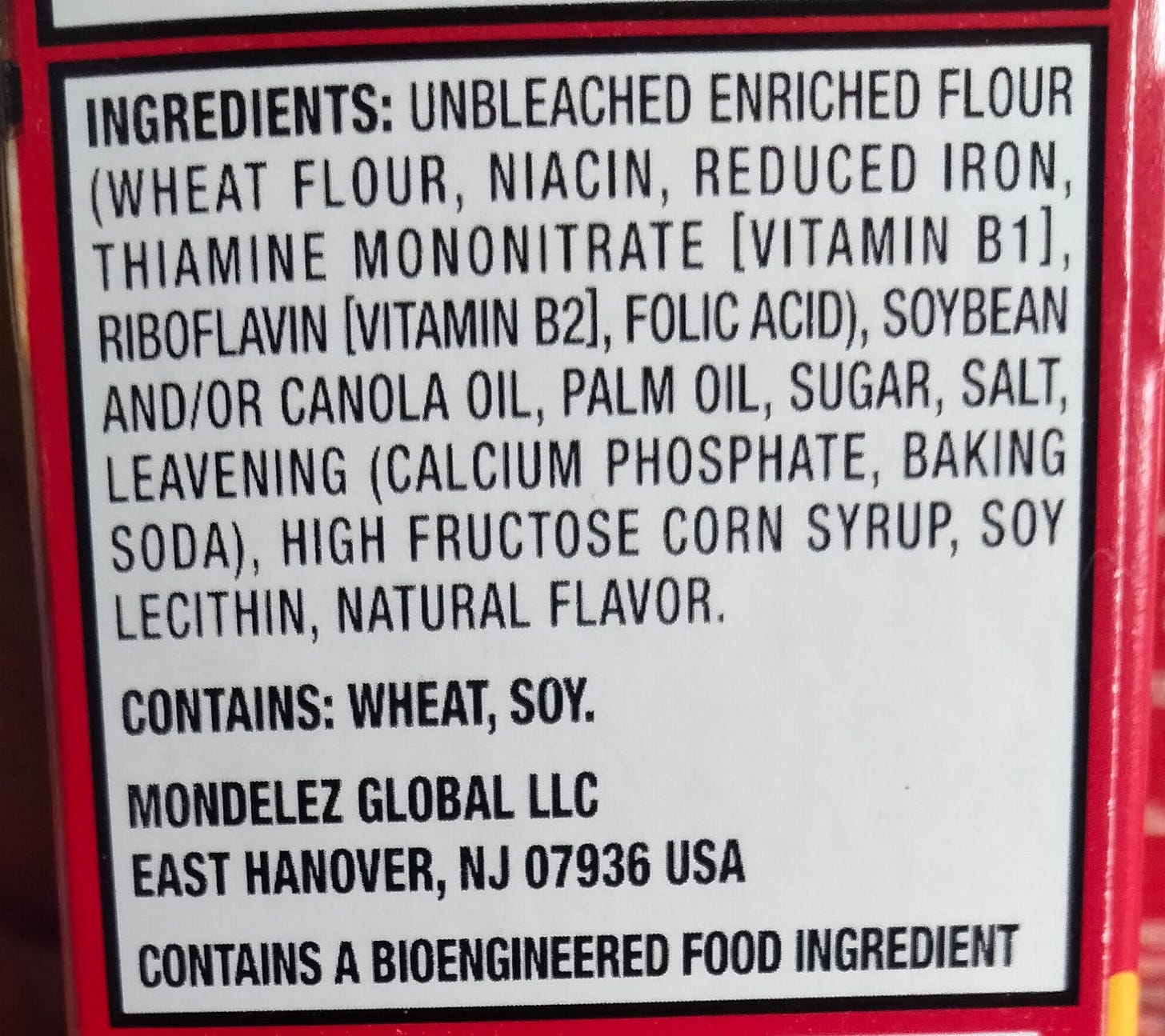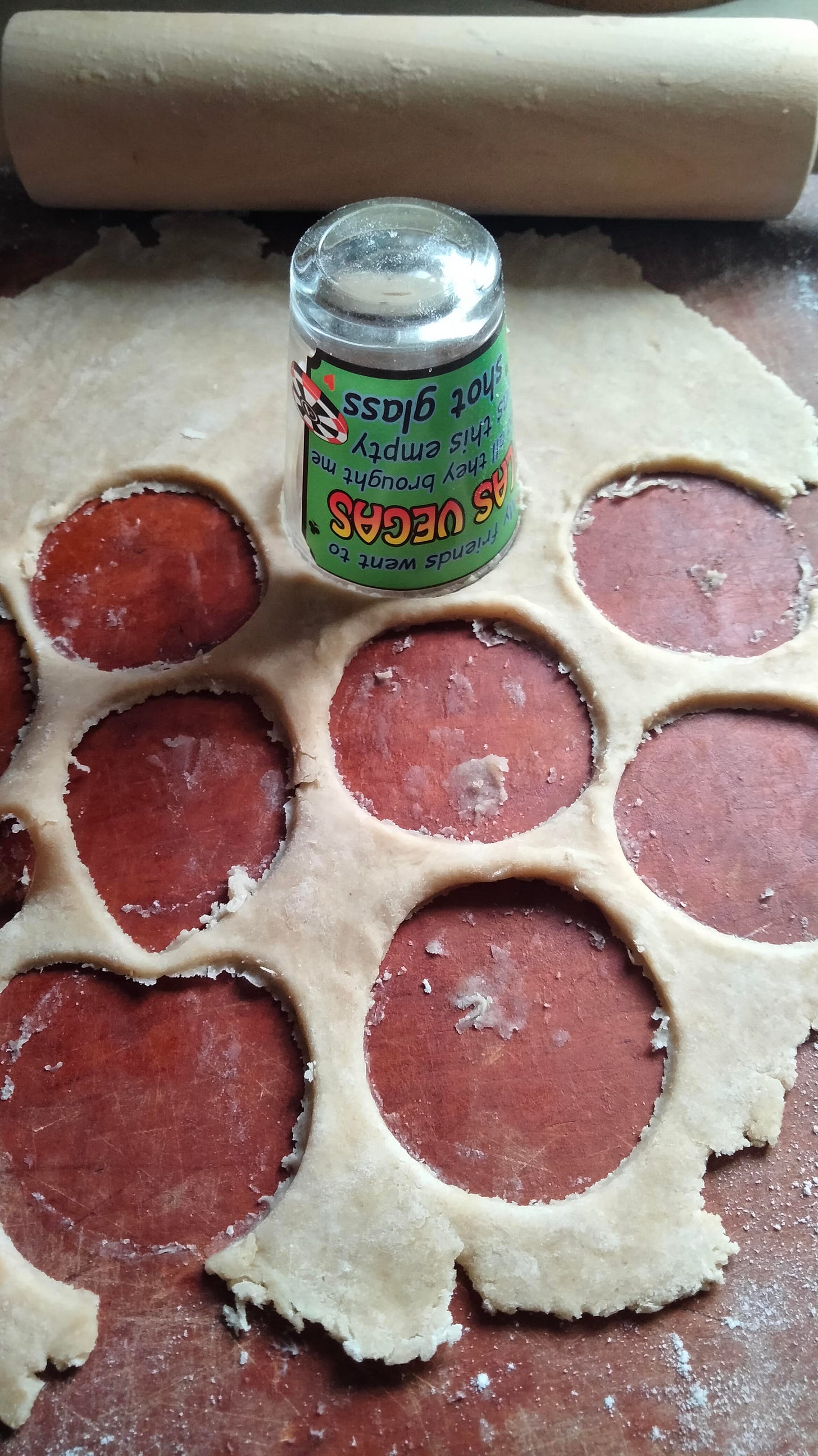If you want the recipe, scroll straight to the bottom. If you want a little Ritz history (both personal and cracker related) then read on.
My last name is Ritz. All my life it’s gone something like this:
“Christin Ritz.”
“Christin what?”
“Ritz. Like the cracker.”
When I was in first grade Nabisco released Ritz Bits Sandwich Crackers accompanied by many television commercials, like this:
All the kids teased me and I hated it. But as I got older, I came to love my name. In many circles people start calling me Ritz or Ritzy completely on their own. It just fits. I sign my artwork C. Ritz. At one point I used to wear a brass Ritz cracker medallion. It’s always been a big part of my identity.
Growing up, we always had Ritz crackers in the house. I jokingly (but seriously) have called people trash for serving Town House brand. Nowadays I don’t eat much processed food, but I do have some occasional processed pleasures and go-to conveniences. A Christmas tradition at my house is dipping Ritz crackers in melted chocolate. The crisp, salty, crunch and the sweet chocolate is a delectable combination. It’s yin and yang coming into divine oneness.
Of course I’ve looked at the ingredients; they’ve never been perfect. I remember when they got rid of trans fats (which were banned in the United States in 2015 but allowed in food until 2018). Somehow for the last few decades they’ve managed to keep them vegan in spite of their buttery rich taste. When I pulled the box out of my lazy susan this winter, I saw it there in all caps. How hadn’t I noticed sooner? CONTAINS A BIOENGINEERED FOOD INGREDIENT
My heart sank. Oh why Ritz? While I could look past the sugar, the palm oil, the high fructose syrup just once a year for my Christmas treat, I cannot look past genetically modified food, even for just one day. I’m not sure when this change occurred, but mandatory labeling started in the United States on January 1, 2022. Perhaps it’s been years already that my beloved Ritz has been contaminated. Since 90% of US Corn is GMO, it’s likely the corn syrup. But it could be the soy lecithin, the canola oil, or something else. I’d say it was the sugar, but they aren’t required to label ingredients if the genetic material is undetectable, and in sugar derived from beets all the genetic material has been stripped away. So even if it’s from a GMO crop that affects the living earth, they need not tell the consumers. The beets from which sugar is derived are largely GMO, but the sugar will not be labeled as such. I dislike the use of the word “bioengineered” in place of genetically modified. It probably tested as less scary in their focus groups. Online the USDA neatly abbreviates it: BE foods.


As my organic vegetable farmer friend told me, “If it’s not certified organic, assume it’s GMO.” Surprisingly, many people aren’t aware that organic food can’t be genetically modified. Therefore it’s a better choice than non-organic food that’s GMO free, because if it’s organic it doesn’t have pesticides or GMOs.

The word “ritz” itself is an homage to Cesar Ritz who lived from 1850-1918. “Ritz” became a noun in 1910, meaning “a symbol or embodiment of high quality or superiority.” Well, I quite like that! Cesar is the Ritz who did extraordinarily well in the hotel business, and it is after him the Ritz-Carlton is named. To think that the word that was attributed to him became a part of the vernacular only 20 years after the start of his hotelier venture shows what a splash he must have made and what sort of reputation he had. Here’s a fun fact: today, February 23, 2025 would be Cesar’s 175th birthday! Viva la Ritz!
According to my vintage 1987 limited edition Ritz Cracker tin, the story goes like this:
“In 1934, Nabisco introduced RITZ Crackers in an effort to provide a daily touch of luxury into the lives of those caught in the midst of the Great Depression. The distinctive golden flavor, the aura of elegance and class provided by RITZ during these difficult times made it an overnight success.”
These vintage Ritz tins are a fairly common find in antique malls. Both my mother and I have a few. They were originally sold filled with crackers as reusable containers to keep your crackers fresh rather than the cardboard box. Because the tins themselves were the container the crackers came in, they reveal the ingredient changes that have occurred over the years.
The earliest ingredient list I have is from 1977:
enriched flour, vegetable and animal shortening (partially hydrogenated soybean oil or coconut oil and lard), sugar, corn sweetener, salt, malted barley flour, sodium bicarbonate and calcium phosphate.
In 1982 they were identical.
Then, by 1987 the tin shows that the coconut oil had been changed to cottonseed oil, the corn sweetener became high-fructose corn syrup, and lecithin was added.
Today the lard is gone and the oils are no longer partially hydrogenated. They have been replaced with soybean and/or canola, and palm oil. The lecithin is from soy (they didn’t give the source in ‘87), and natural flavor has been added. And they are genetically modified (aka “bioengineered.”)
Thus, my search for a DIY Ritz Cracker began. My grandfather, John Ritz, was born 14 years before the debut of Nabisco’s Ritz Cracker (I wonder if he was ever teased in school...) Since my family name predates Nabisco’s snack cracker, I hereby declare my lineage and the crackers made in the home kitchens of the Ritzes to be the only authentic Ritz crackers! After trying a few recipes online, and tinkering with them to achieve the flaky perfection of Ritz, I have settled on this adaptation. I believe these are the perfect substitute for store-bought variety my grandmother used as a topping on her outstanding macaroni and cheese. And I know they’ll be decadent when dipped in chocolate next Christmas!
While I hate GMOs and wish they didn’t exist, in a way I’m grateful to have gotten the push to make my own, simpler, healthier, more wholesome, and just-as-delicious version. Home cooked food, made with real ingredients and love is always superior. And in their high-quality, superiority, these homemade crackers are by definition ritzy, in a way that Nabisco’s processed, bioengineered, fake food will never be.
Here’s Ritz’s Ritzy Ritzes!
If you try them, I’d love to hear what you think! They’re very easy to make!
Ingredients (organic if possible):
1 cup all purpose flour
1/4 tsp sea salt
1 1/2 tsp baking powder
4 tbsp (1/2 stick) cold unsalted butter *see non-dairy version below*
1 tbsp sunflower oil
1 tbsp maple syrup
2 tbsp cold water
a couple more pinches of sea salt
Mix dry ingredients in a mixing bowl. Cut butter into pats and drop into dry ingredients, coating with mixture. With a fork, blend the butter into the flour mixture until very crumbly. Add oil and maple syrup and mix in with fork. Add water and using your hands, combine until a dough forms. If it doesn’t hold together, add a few drops of water at a time just until it can form a ball.
Roll out the dough, one half at a time, onto a floured surface. Dust with flour as needed to keep from sticking and the rolling pin too. Roll to be under a 1/4 inch thick. Use a cookie or biscuit cutter to cut out crackers. A shot glass is the perfect size if you don’t have a cookie cutter this small. Place the cut crackers onto a parchment paper lined cookie sheet. Continue to combine and roll excess dough until you have used it all up.
With the fat end of a toothpick, poke 7 holes per cracker. One hole in the center and 6 around it. Sprinkle 2 small pinches of salt over the entire cookie sheet. Place the cookie sheet in the refrigerator so the dough can chill while you preheat the oven to 400 degrees F. Chilling the dough before baking results in a flakier texture in the finished crackers.
Bake on a center oven rack for 12 minutes. Remove from parchment paper right away and let cool on a plate.
Yields 48 crackers
Enjoy on their own or with any ritzy topping you desire!
*Non-Dairy Version*
I have tried substituting Earth Balance in place of butter. The result is a cracker that is very tasty, but doesn’t have the classic flaky texture. The dough is also much stickier, so if you try this I suggest refrigerating the dough for an hour before rolling it out.












I am noticing bio-engineered listed on a lot of packaged foods and sometimes you have to hunt for those words on the label. This should be noted right on the front of the package but we all know how they like to hide the bad stuff.